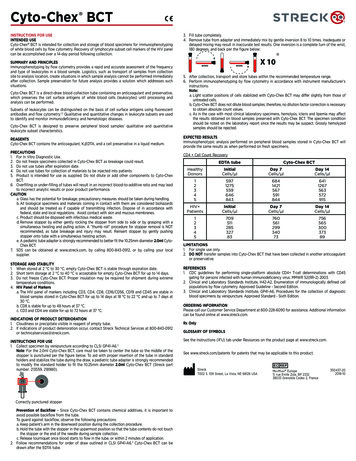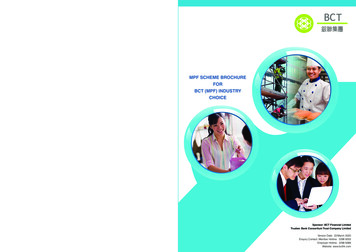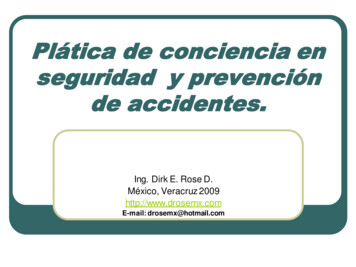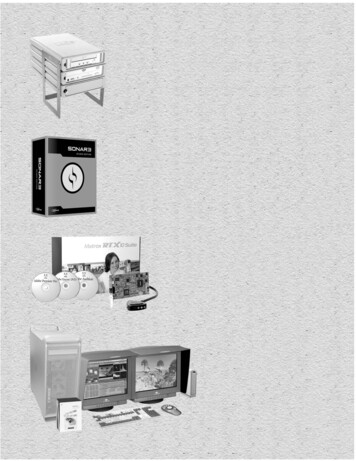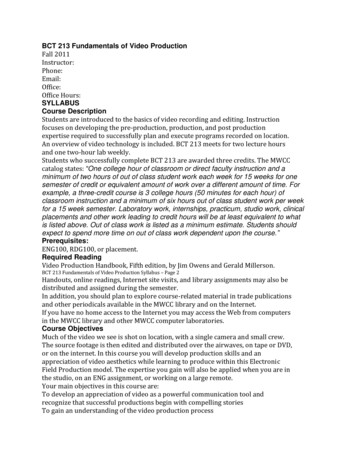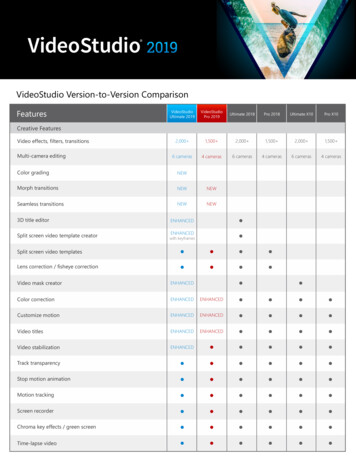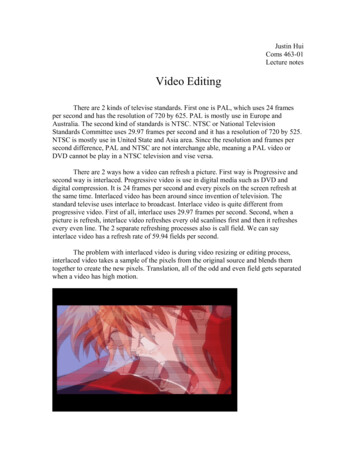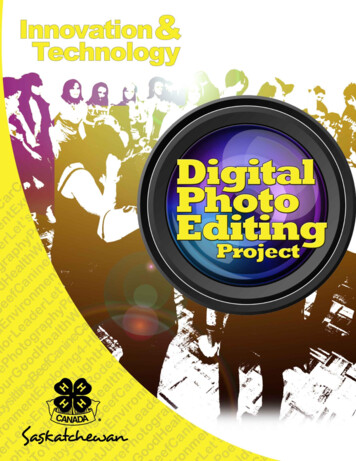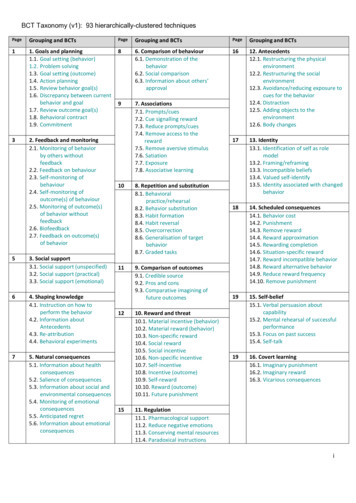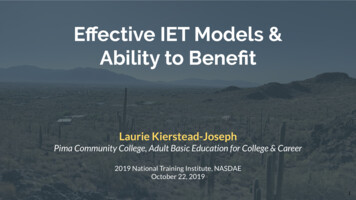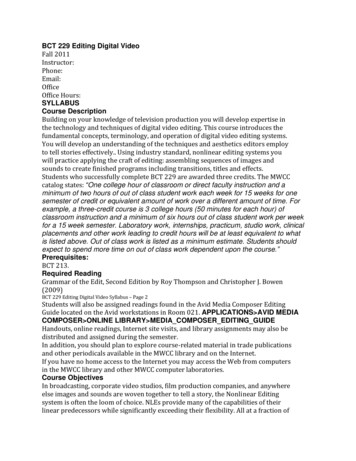
Transcription
BCT 229 Editing Digital VideoFall 2011Instructor:Phone:Email:OfficeOffice Hours:SYLLABUSCourse DescriptionBuilding on your knowledge of television production you will develop expertise inthe technology and techniques of digital video editing. This course introduces thefundamental concepts, terminology, and operation of digital video editing systems.You will develop an understanding of the techniques and aesthetics editors employto tell stories effectively. Using industry standard, nonlinear editing systems youwill practice applying the craft of editing: assembling sequences of images andsounds to create finished programs including transitions, titles and effects.Students who successfully complete BCT 229 are awarded three credits. The MWCCcatalog states: “One college hour of classroom or direct faculty instruction and aminimum of two hours of out of class student work each week for 15 weeks for onesemester of credit or equivalent amount of work over a different amount of time. Forexample, a three-credit course is 3 college hours (50 minutes for each hour) ofclassroom instruction and a minimum of six hours out of class student work per weekfor a 15 week semester. Laboratory work, internships, practicum, studio work, clinicalplacements and other work leading to credit hours will be at least equivalent to whatis listed above. Out of class work is listed as a minimum estimate. Students shouldexpect to spend more time on out of class work dependent upon the course.”Prerequisites:BCT 213.Required ReadingGrammar of the Edit, Second Edition by Roy Thompson and Christopher J. Bowen(2009)BCT 229 Editing Digital Video Syllabus – Page 2Students will also be assigned readings found in the Avid Media Composer EditingGuide located on the Avid workstations in Room 021. APPLICATIONS AVID MEDIACOMPOSER ONLINE LIBRARY MEDIA COMPOSER EDITING GUIDEHandouts, online readings, Internet site visits, and library assignments may also bedistributed and assigned during the semester.In addition, you should plan to explore course-related material in trade publicationsand other periodicals available in the MWCC library and on the Internet.If you have no home access to the Internet you may access the Web from computersin the MWCC library and other MWCC computer laboratories.Course ObjectivesIn broadcasting, corporate video studios, film production companies, and anywhereelse images and sounds are woven together to tell a story, the Nonlinear Editingsystem is often the loom of choice. NLEs provide many of the capabilities of theirlinear predecessors while significantly exceeding their flexibility. All at a fraction of
the cost. In this course you will be introduced to the primary components of a NLEsystem and survey the various NLE products on the market today. Using MWCC’sNLE systems you will learn the basics of their operation and employ them tocomplete a variety of editing assignments. You should recognize that theseexperiences build fundamental skills and knowledge applicable to otherprofessional NLE systems you will encounter in your career.The main objectives in this course are:To gain an appreciation of the legacy of film and video editingTo become familiar with the basic visual tools the editor uses to tell a storyTo identify specific components of an NLE systemTo understand and appreciate the importance of the organizing your editproject efficientlyTo become familiar with the technical specifications of digital video andaudioTo learn how to correctly ingest video and audio for use in an NLETo learn how to use an NLE interface to efficiently perform basic editingoperationsTo learn how to use the advanced features of an NLE to trim and refine theedited projectTo gain an understanding of the effective use of audio in postproductionTo become familiar with the basic audio controls provided within an NLETo learn how to create and edit video transitions within an NLEBCT 229 Editing Digital Video Syllabus – Page 3To become familiar with various workflow styles employed when editingdifferent types of productionTo identify key qualities of effective text and graphic design for videoTo learn how to use an NLE’s titling tool to create effective textTo become familiar with the options the editor has available for “printing”and distributing the final productTo demonstrate your knowledge and understanding of an NLE system’soperation by editing several projectsTeaching ProceduresClass meetings consist of demonstration and discussion of the concepts and skillsassociated with editing film and video. You will practice and display yourunderstanding of this content through, class participation, assigned readings,quizzes and exams, the completion of editing assignments and the completion of aclassroom presentation.MediaYou are required to provide DVD’s or other media necessary to archive yourproduction work.Grading PolicyFinal grades will be calculated as follows:Editing Assignments 40%Exams (3) 25%Online quizzes 10%Learn From Example Presentation 15%
Final Exam 10%Students are expected to complete an on-line quiz for each chapter assigned fromthe text. Quizzes will be accessible for a limited period of time. I will distribute aseparate schedule listing all on-line quizzes and the dates of their availability.Learn From Example (LFE)Each student will prepare a 20 minute presentation introducing a film ortelevision program which has received an industry award for editing.Motion picture editors receive Eddie (American Cinema Editors) and Oscar(National Academy of Motion Picture Arts & Sciences) awards for editing.Winning films may be searched through these links:BCT 229 Editing Digital Video Syllabus – Page 4http://awardsdatabase.oscars.org/ampas nt/ev0000017/Television editors receiving Emmy awards (Academy of Television Arts &Sciences) for picture editing may be searched at:http://www.emmys.com/award history searchThe LFE presentation should include a brief introduction to the editorincluding other projects worked on; a synopsis of the project receiving theaward; commentary and critique from critics and scholars regarding theeditor’s technique and style; comments from the editor if available; andrepresentative samples from the award-winning project.All sources must be properly attributed and cited.LFE topics and presentation dates will be determined within the first severalweeks of the semester. Presentations will begin on October 17 and onepresentation will be scheduled for each of the following weeks.All written assignments must be created in a word processing computer applicationand are expected to meet the standard of college-level grammar usage, spelling, andsentence structure.IN FAIRNESS TO ALL STUDENTS IN THE CLASS, AND TO CONFORM TO PROFESSIONALPRACTICES ALL DEADLINES MUST BE STRICTLY OBSERVED.AttendanceMuch of what you will learn in this course will result from demonstration and handson experience. Therefore every absence and incidence of tardiness results in amissed opportunity for you to achieve your goals in this course.Due to the quantity of content we will cover and the logistics of schedulingequipment and facilities it will be difficult if not impossible to make up for the workmissed due to absence. If you don’t actively participate you won’t meet the courseobjectives and your final grade will reflect your lack of success.Attendance and punctuality is required. Attendance will be taken at the beginning ofeach meeting. Arrival after the roll has been taken or leaving before the end of classis considered one-half an absence.THIS CLASS MEETS ONLY ONCE EACH WEEK. MISSING ONE CLASS IS EQUIVALENT TOMISSING AN ENTIRE WEEK OF CLASSES. IF YOU MISS MORE THAN ONE CLASS, I WILLASSUME YOU ARE NOT INTERESTED IN COMPLETING THE COURSE AND WILL WITHDRAWYOU.It shall be your responsibility to meet with me regarding multiple absences to
receive permission to remain in the course.Emergencies and illnesses occur for all of us. You should save your absence forwhen it is truly needed. I hope you won’t need it.BCT 229 Editing Digital Video Syllabus – Page 5If you miss a meeting, it is your obligation to determine what was missed, completeall assigned work, and consult with class members to get notes on the missedmaterial. Don’t hesitate to contact me if you have any questions.WithdrawalCollege policy states a student who officially withdraws from a course up to andincluding the last day of the ninth week of the semester will receive a grade of W(withdrawn without grade point penalty). Students must follow the college’sprocedure as published in the current catalog to withdraw from a course. The lastday to withdraw from this course without grade point penalty is November 8.Course withdrawals will not be processed after the ninth week of the semester.Students who stop attending class after the ninth week of the semester will receivean F grade.Classroom Conduct:Academic dishonesty policies and the penalty for such violations are outlined in theMWCC student handbook.Cheating means receiving unauthorized help on an assignment, quiz or examination.It is wrong to use unauthorized sources, notes, books, and other materials during aquiz or exam.Plagiarism is the process of submitting another individual’s work as your own, andthis will not be tolerated. You must document your sources. Plagiarism is stealing; itis academically and morally wrong. Students found guilty of such a practice willreceive a zero grade for the assignment, and may be subject to withdrawal from thecourse and college.While in class, students are expected to cooperate and focus on learning. Studentswho disrupt the classroom and distract other students will be asked to leave.Students are expected to treat faculty and fellow students with respect. Prejudicedlanguage and behavior are not tolerated in the classroom. It is inappropriate to raiseone’s voice, use vulgar language, or attempt to intimidate another.Students should strive to be alert throughout the class, listen carefully to theinstructor, media presentations, and other students. Behavior such as sleeping,reading, and studying will not be tolerated.Food is not allowed in the classroom. College policies permit drinks that are incovered, non-glass containers. No food or drinks are permitted in studios, controlrooms, edit suites, or other production facilities.Refer to your copy of the student handbook and become familiar with other collegepolicies and procedures.BCT 229 Editing Digital Video Syllabus – Page 6Statement on DisabilitiesStudents with documented disabilities (physical, emotional, learning, and/orothers) who believe that they may need accommodations in this class areencouraged to contact the Counselor for Students with Disabilities in Room 135, orat extension 120, as soon as possible to ensure that such accommodations are
implemented in a timely fashion.Class Schedule:Readings and assignments should be completed before the class meeting for whichthey are listed.September 12 Course OrientationNonlinear Video Editing Overview and Review“The Cutting Edge” viewingSeptember 19 What is Editing?Review of Basic Media Composer EditingLearning From Example – Walter MurchSeptember 26 Shooting for the EditAvid Media Access WorkflowOctober 3 Fine Tuning the Edit – TrimmingCustomizing SettingsOctober 10 Columbus Day - no classesOctober 12 (Wednesday – Monday Schedule)Editing AudioTimeline EditingExam #1October 17 Introduction to Final Cut ProLearning From Example #1October 24 Introduction to Final Cut Pro (continued)LFE #2October 31 Introduction to Effects and KeyframingLFE #3November 7 Importing GraphicsTitling in Media ComposerLFE #4November 15 Color CorrectionDelivery & CompressionLFE# 5Exam #2November 21 Project ManagementLFE #6BCT 229 Editing Digital Video Syllabus – Page 8November 28 Styles and WorkflowsDecember 5 Multicamera EditingDecember 12 Multicamera Editing (continued)Exam #3December 19 - 22 FINAL EXAM Meeting as scheduled by MWCCAdministrationIt may become necessary to change the schedule to accommodate specialopportunities or include additional topics of interest.During the semester you will have the opportunity to participate in additionalproduction activities outside of the course. I suggest you take advantage of theseopportunities to further develop your production expertise.
In broadcasting, corporate video studios, film production companies, and anywhere else images and sounds are woven together to tell a story, the Nonlinear Editing . BCT 229 Editing Digital Video Syllabus - Page 6 Statement on Disabilities Students with documented disabilities (physical, emotional, learning, and/or
